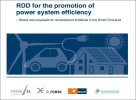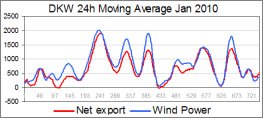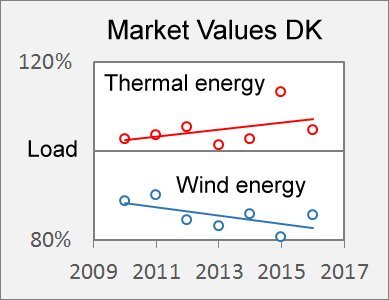Integration of Renewables
| 30 January 2016: | |
|
Will Germany Meet its CO2 Target in 2020?
| |
| 5 January 2016: |
|
Denmark more and more Dependent on Foreign Resources for Balancing the Power System
Wind and solar power are non-dispatchable power sources. Access to sufficient flexible resources is necessary in order to avoid interruptions of supply and to limit curtailment of renewables. So far, neighbouring countries supplied most of the regulating work for the Danish electricity supply system. The Danish dependency on foreign resources increases with the wind and solar power capacity.
|
| 5 October 2015: |
|
Towards 50% Wind Electricity in Denmark
On 23 September I informed the Energy Group under European Physical Society (EPS) about the integration of wind power into the Danish electricity supply system.
|
| 12 June 2015: |  |
|
Lack of Social Sciences in Danish Smart Grid Research
Denmark has high ambitions for the development and implementation of Smart Grid. A working group has evaluated Danish Smart Grid research. Several shortcomings have been identified. One major problem is that research in market design and communication is lagging behind.
Links: An overview of findings, A summary in English
My presentation at the EnergiForsk15 conference (version in English). |
| 13 December 2014: | |
|
New Danish Report on Smart Grid Development
The Smart Grid concept is expected to contribute to balancing the fluctuating power from wind turbines and solar panels. The Danish energy research programs have published a report on the need for further Smart Grid development in order to achieve efficient operation with a 50% wind energy share in 2020.
Link to the summary in English and to the full report in Danish.
|
|
| 5 June 2014: | |
|
Denmark depends on Foreign Balancing Services
Is Danish wind power integration a success? Or is Danish wind energy being given away for nothing?Here is my contribution to the myths. |
|
| 7 January 2014: | |
|
Filling Wind Power Gaps
50% wind energy by 2020 is a Danish political target. So far there has been only a limited debate on the sources and the economy of the remaining 50%.
This article was printed in two Danish magazines in January 2014.
|
|
| 16 November 2013: | |
|
Californian Utilities must Build Energy Storages
Now the California Power Utility Commission (CPUC) has set energy storage goals for the Californian power utilities.
This is my introduction
|
|
| 29 September 2013: | |
|
The German Pumped Storage Paradox
Pumped storage is supposed to be the perfect technology for smoothing load variations. Now Vattenfall seems to be about to close its German pumped storage plant due to loss of money.
Here is my economic evaluation. |
|
| 23 July 2013: | |
|
100% RE is a Misleading Target
Crucial decisions on the development of the Danish energy systems during the period 2020-2035 must be made in the near future. A comprehensive energy analysis from The Danish Energy Association has asked some very interesting questions.
Read my introduction
|
|
| 19 July 2013: | |
|
German Grids Balancing on a Knife Edge
The German Bundesnetzagentur has published its report on the supply situation for electricity and gas during the winter season 2012/13. The system balance is increasingly depending on export of electricity.
Read my comment
|
|
| 14 April 2012: | |
|
Frequent Curtailments of Wind Power in Germany
Press reports on recent critical grid conditions in Germany roused my curiosity for more information. Available data indicates frequent stressed situations with curtailment of wind power. The risk of a blackout is taken seriously in Germany. A report from 2011 has evaluated the possible consequences and recommends actions for improving the resilience of vital infrastructure sectors. Germany is being prepared for future blackouts. . . . . Read more |
|
| 22 November 2012: | |
|
PV can Reduce Overflow and Fuel Consumption
The Government has put a brake on the photovoltaic (PV) development in Denmark. I have analysed the interaction between PV, wind and CHP. A certain share of PV seems to reduce the imbalances, caused by wind power. From an operational point of view the annual wind energy should be about three times the PV energy.
See the results here
|
|
| 9 September 2012: | |
|
A Vision for the German Power System in 2050
Germany has ambitious plans for the use of renwable energy. The German Energy Agency (dena) has published a new study on the integration of renewable energy souces in Germany. The study is based on guiding scenarios published by the Federal Ministry for the Environment, Nature Conservation and Nuclear Safety (BMU).
Read about a Germany with 86% renewable electricity here
The new dena study (in German) Guiding Scenarios 2010 (in German with an English summary on page 31-60) |
|
| 14 April 2012: | |
|
Frequent Curtailments of Wind Power in Germany
Press reports on recent critical grid conditions in Germany roused my curiosity for more information. Available data indicates frequent stressed situations with curtailment of wind power. The risk of a blackout is taken seriously in Germany. A report from 2011 has evaluated the possible consequences and recommends actions for improving the resilience of vital infrastructure sectors. Germany is being prepared for future blackouts. . . . . Read more |
|
| 29 March 2012: | |
|
IEA Flexibility Index - An Incomplete Yardstick
The International Energy Agency (IEA) has presented a method for the assessment of the amount of wind energy which can be handled by a power system. Under the present conditions Denmark should be able to absorb 63% wind energy. The initiative is exciting but the method is still incomplete. . . . . . Read more |
|
| 22 March 2012: | |
|
German PV installation running wild
In 2011 7.5 GW PV systems were installed in Germany or 3 times as much as expected. Now the Federal Government pulls the brake. Read more |
|
| 9 January 2012: | |
|
German Network Agency opens debate on smart grids
The German Bundesnetzagentur (The Federal Network Agency) has published a 50 page paper (in German) with interesting views on smart grids. The agency calls for a debate.
See my contribution to the debate here. |
|
| 21th November 2011: | |
|
Denmark goes for Smart Grids
The Danish Ministry for Climate, Energy and Building has presented its Smart Grid intentions in a report: "Main Report - The Smart Grid Network's recommendations". The recommendations are quite sensible, but it is debatable if the increasing risk of power failures has been properly addressed.
See my comments with links to the documents. |
|
| 26th April 2011: | |
|
Wind power creates export of electricity
 Danish wind energy is not supposed to be exported. However, it cannot be refused that wind power and export of electricity are closely related. Danish wind energy is not supposed to be exported. However, it cannot be refused that wind power and export of electricity are closely related.
Again in 2010 Danish interconnectors had poor availability. Furthermore the Norwegian hydro production was much lower than in a normal year. Read more in Statistical Survey 2010.
The survey also includes wind power data from Germany and Ireland.
|
|
| 22nd October 2010: |
|
Interview on Nuclear Power in Denmark
Could the present power system be extended by nuclear power?
Julie Søgaard from Radio Denmark asked me this surprising question.. Read my answer here. |
| 24th May 2010: |
|
EWIS report on wind power integration in Europe 2015
The European Wind Integration Study has published a path breaking report. Large scale analyses for nearly 30 European countries have been made. The analyses include market performance, grid flows and system security for the year 2015.
The installed wind power is assumed to grow from about 70 GW in 2008 to about 140 GW in 2015 causing high flows and increased congestion in the grid. A series of technical measures have been planned. See: Comment on the EWIS report See: EWIS Final Report 2010. |
| 13th May 2010: |
|
Somewhere the wind must be blowing
Aggregating wind power for a large geographical area results in a more smooth production. In the UK it is widely believed that UK is so large that a certain minimum production from dispersed wind power plants can always be counted on.
Unfortunately time series for wind power output have not been published in the UK in the same way as in Denmark and Germany. Therefore I have used Danish and German data in order to shed light on the matter for a geographic area of similar extent as the UK. See my article in New Power UK, March 2010 |
| 30th March 2010: |
|
Continued debate on CEPOS report
The authors of the CEESA report have responded to my criticism.
See the CEESA comment The new comment repeats that Danish power plants could have reduced production during periods with high wind power output and that the export therefore was competitive thermal power. On the other side it remains unchallenged that the net export of electricity reflects the irregular variations of the wind power while the thermal power plants rather follow the daily cycles of electricity consumption. This observation indicates that the export is highly influenced by wind power. The export of electricity cannot be traced objectively. Therefore it is strange that a complete rejection of one of the two interpretations is so important. One reason could be that the market value of export can be calculated and compared with the cost of wind energy. I must add that nothing in the new comment changes my criticism of the professional quality of the first CEESA report. See the other references below |
| 5th March 2010: |
|
Debate on CEPOS report
Last year the Danish Center for Political Studies (CEPOS) published the report Wind Energy – The case of Denmark. The report points out that a main element of the praised Danish integration of wind power is leaving absorbtion of wind power variability to larger neighbouring countries.
Questioning the Danish myth on outstanding integration of wind power causes anger. The report Danish Wind Power – Export and Cost was published by Aalborg University, financed by CEESA and signed by a number of well-known Danish energy experts. Based on poor professional evidence the CEESA report categorically rejects the analyses and conclusions of the CEPOS-report and particularly my calculation of wind energy export. See my answer: Wind Power Variations are Exported. The CEESA report: Danish Wind Power – Export and Cost The CEPOS report: Wind Energy - The Case of Denmark |
| 4th December 2009: |
|
Challenges of Climate Change
Reduction of carbon emission to the atmosphere has become a highly prioritized national and international target. It is incredible that we feel so rich and secure that our essential concern relates to long term climate changes. This condition cannot last. More urgent global problems will set another agenda long before the climate change is perceptible.
Several companies, municipalities and islands have declared themselves to be carbon neutral because they have purchased carbon free energy. But providing carbon free energy is only a part of the solution. The heavy problems have been pushed on somebody else. The electricity system must also provide a permanent balance between consumption and generation and it must supply heat for the large number of Danish district heating systems. In 2025 Denmark is supposed to have twice the present wind energy corresponding to half of the electricity consumption. Implementing the necessary transition of the power system will be an exciting development process aiming at securing both electricity and heat supply and minimizing the waste of wind energy. Read my note om 50% wind energy - Options and challenges |
| 15th September 2009: |
|
CEPOS: The hidden cost of wind energy
The production of wind energy in Denmark is about 20% of the electricity demand, but due to the intermittency of wind power most wind energy has been exported, says the Danish Center for Political Studies (CEPOS), and the wind energy utilised in Denmark is unreasonably expensive to Danish consumers.
See the Heritage Foundation or the full report (3 MB) |
| 11th September 2009: |
|
EcoGrid.dk at Nordic Wind Power Conference 2009
EcoGrid.dk is a large scale project for the integration of wind power. Phase 1 of the project was terminated with a workshop in May 2009 at Energinet.dk. The most important messages were presented by Thomas Ackermann on NWPC'2009.
See Thomas Ackermann's presentation, a summary paper or the project web site |
| 10th September 2009: |
|
The Spot Price Study at NWPC'2009
The spot price study was made earlier this year for the Renewable Energy Foundation (read more here). The main results were shown at the conference, NWPC'2009, at Bornholm (a Danish island in the Baltic Sea) on the 10th and 11th September 2009. It was emphasized, that the capacities of the interconnectors during the 3 years, which have been analysed, for technical or other reasons are much below the nominal values. The problem can hurt the future utilisation of wind power.
See the paper and the presentation for NWPC'2009 |
| 12th May, 2009: |
|
The UK power system must be prepared for large scale wind power
Those who claim that Denmark skilfully has integrated 20% wind energy in the electricity supply system are exaggerating. It is more accurate to say that Denmark and Germany as an entity has integrated 7% wind energy. This is one of the surprising results of an examination of Danish and German data form the years 2006 to 2008.
The Danish achievements have mainly been possible due to dynamic international markets and strong interconnections to large neighbouring countries. Therefore Renewable Energy Foundation has pointed out that Britain cannot just proceed in the wake of the Danish wind power development. An ambitious program for British wind power must be accompanied by new measures for maintaining power system balance and security. Read more... |
Opdateret d. 30.4.2017
